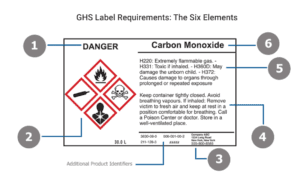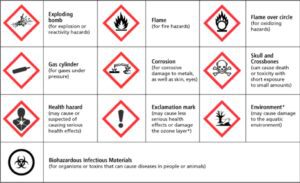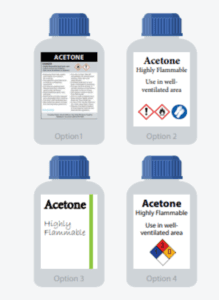In 2012, OSHA adopted new requirements for employers pertaining to the labeling of chemical containers. They adopted the Globally Harmonized System (GHS) requirements. These label formats are used in countries all around the world. Since we live in an international market, this makes it easier to identify hazardous chemicals and make conditions safer. 1910.1200, which is OSHA’s hazard communication standard, is applicable to both general industry and construction. Below are some things to look for to ensure that you are meeting the requirements and understand what each element of the label means.
Primary Containers
Primary containers are the containers that a chemical is shipped in. GHS labels require the following elements:
- Signal word – “Warning” or “Danger”; this gives an understanding of how hazardous the chemical is.
- Pictograms – Simple pictures that reveal the hazards associated with a chemical. These are universal within the GHS system, meaning that a label in Spanish or Mandarin would have the same pictograms.
- Manufacturer information – Shows where the chemical came from, in case you need to contact the manufacturer.
- Precautionary statement – Describes the precautions you need to take when handling the chemical.
- Hazard statement – Lists the dangers associated with the chemical.
- Product Identifier – Displays the common name or reference for the chemical.

Pictograms – If you see any of the pictures shown below on a container, this is what they mean:

What do you do if there isn’t a label?
Replacement labels can often be found on the manufacturer’s website, or they can be requested from the manufacturer. Until a container is properly labeled, it cannot be on-site.
Secondary Containers
Secondary containers are used when you take a chemical and put it into a new container. There are fewer requirements for a secondary container label, but it still needs to be labeled. Employers can either replicate the manufacturer’s shipped container label or create their own workplace label that contains the chemical information. You can order templates for secondary labels online. The main requirements for what must appear on a secondary label are:
- The product identifier; and
- A combination of chemical information that reveals the hazards associated with that chemical.
Shown below, here are four examples of secondary labels, all are compliant with 1910.1200:

What about water?
Even water containers need to be labeled. Spray containers and large drums of water need to be labeled to indicate what is inside. There are no hazards with water, so a simple label that reads “WATER” or “H2O” will suffice.
